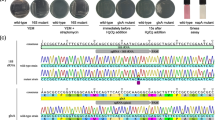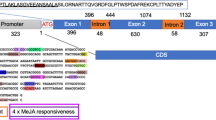Abstract
The Aspergillus niger phytase-encoding gene (phyA) has been constitutively expressed in wheat. Transgenic wheat lines were generated by microprojectile bombardment of immature embryos, using the bar-Bialaphos selection system. The bar and the phyA gene expression were controlled by the maize ubiquitin-1 promoter. To ensure secretion and glycosylation of the microbial phytase, an expression cassette was designed (Ubi-SP-Phy) where an α-amylase signal peptide sequence was inserted between the promoter and the phytase coding region. A similar cassette was constructed without the signal peptide sequence (Ubi-Phy). Five lines of fertile wheat transformed with the Ubi-SP-Phy were generated and two lines with the Ubi-Phy construct. The inheritance of the phyA gene was monitored through three generations. Western blotting of leaf and seed derived protein revealed the presence of an immunoreacting polypeptide of the size expected for the Aspergillus phytase. Up to 25 days after pollination, the heterologous phytase was exclusively present in the pericarp-seed coat-aleurone fraction. Thereafter, it accumulated in the endosperm in amounts exceeding that found in the seed coat and aleurone. The phyA mRNA and derived protein could at no stage be detected in the embryo. The Ubi-SP-Phy transgenic seeds exhibited up to 4-fold increase of phytase activity while up to 56% increase was found in Ubi-Phy plants. It is concluded that a functional Aspergillus phytase can be produced in significant amounts in wheat grains. This may be of relevance for improving the phytate-phosphorus digestibility when wheat grains are used for non-ruminant animal feed.
Similar content being viewed by others
References
Benway DA, Weaver CM: Assessing chemical form of calcium in wheat, spinach, and kale. J Food Sci 3: 605-608 (1993).
Beudeker RF, Pen J: Development of plant seeds expressing the Aspergillus niger phytase gene for use in monogastric animal feeds. In: Jones DD (ed.) Proceedings of the 3rd International Symposium on the Biosafety Results of Field Tests of Genetically modified Plants and Micro-organisms pp. 299-304. University of California (1994).
Bevan M, Barnes WM, Chilton M-D: Structure and transcription of the nopaline synthase gene region of T-DNA. Nucleic Acids Res 11: 369-385 (1983).
Blechl AE, Anderson OD: Expression of a novel high-molecular-weight glutenin subunit gene in transgenic wheat. Nature Biotechnol 14: 875-879 (1996).
Bradford MM: A rapid and sensitive method for the quantitation of microgram quantities of protein utilising the principle of protein-dye binding. Anal Biochem 72: 248-254 (1976).
Brinch-Pedersen H, Galili G, Knudsen S, Holm PB: Engineering of the aspartate family biosynthetic pathway in barley (Hordeum vulgare L.) by transformation with heterologous genes encoding feed-back-insensitive aspartate kinase and dihydrodipicolinate synthase. Plant Mol Biol 32: 611-620 (1996).
Christensen AH, Sharrock RA, Quail PH: Maize polyubiquitin genes: structure, thermal perturbation of expression and transcript splicing, and promoter activity following transfer to protoplasts by electroporation. Plant Mol Biol 18: 675-689 (1992).
Cornejo M-E, Luth D, Blankenship KM, Anderson OD, Blechl AE: Activity of a maize ubiquitin promoter in transgenic rice. Plant Mol Biol 23: 567-581 (1993).
Denbow DM, Graubau EA, Lacy GH, Kornegay ET, Russell DR, Umbeck PF: Soybeans transformed with a fungal phytase gene improve phosphorus availability for broilers. Poultry Sci 77: 878-881 (1998).
Engelen AJ, ven der Heeft FC, Randsdorp PHG, Smit ELC: Simple and rapid determination of phytase activity. JAOAC Int 77: 760-764 (1994).
Feinberg AP, Vogelstein B: A technique for radiolabelling DNA restriction endonuclease fragments to high specific activity. Anal Biochem 132: 6-13 (1983).
Gibson DM, Ullah ABJ: Phytases and their action on phytic acid. In: Morré DJ, Boss WF, Loewus FA (Eds.) Inositol Metabolism in Plants, pp. 77-92. Wiley-Liss, New York (1990).
Guidet F, Rogowsky P, Taylor C, Song W, Langridge P: Cloning and characterisation of a new rye-specific repeated sequence. Genome 34: 81-87 (1991).
van Hartingsveldt W, van Zeijl CMJ, Harteveld GM, Gouka RJ, Suykerbuyk MEG, Luiten RGM, van Paridon PA, Selten GCM, Veenstra AE, van Gorcom RFM, van den Hondel CAMJJ: Cloning, characterisation and overexpression of the phytase-encoding gene (phyA) of Aspergillus niger. Gene 127: 87-94 (1993).
Hood EE, Witcher DR, Maddock S, Meyer T, Baszcynski C, Bailay M, Flynn P, Register J, Marshall L, Bond D, Kulisek E, Kusnadi A, Evangelista R, Nikolov Z, Wooge C, Mehing RJ, Hernan R, Kappel WK, Ritland D, Li CP, Howard JA: Commercial production of avidin from transgenic maize: characterization of transformant, production, processing, extraction and purification. Mol Breed 3: 291-306 (1997).
Irving GCJ: Phytase, In: Cosgrove DJ (Ed.), Inositol Phosphates: Their Chemistry, Biochemistry and Physiology. (Studies in Organic Chemistry 4), pp. 85-186. Elsevier Scientific Publishing Company, Amsterdam (1980).
Jensen LG, Olsen O, Kops O, Wolf N, Thomsen KK, von Wettstein D: Transgenic barley expressing a protein-engineered, thermostable (1, 3-1,4)-α-glucanase during germination. Proc Natl Acad Sci USA 93: 3487-3491 (1996).
Jongbloed AW, Mroz Z, Kemme PA: The effect of supplementary Aspergillus niger phytase in diets for pigs on concentration and apparent digestibility of dry matter, total phosphorus, and phytic acid in different sections of the alimentary tract. J Anim Sci 70: 1159-1168 (1992).
Lantzsch HJ, Hillenbrand S, Scheuermann SE, Menke KH: Comparative study of phosphorus utilization from wheat, barley and corn diets by young rats and pigs. J Anim Physiol Anim Nutr 67: 123-132 (1992).
Li J, Hegeman CE, Hanlon RW, Lacy GH, Denso DM, Grabau EA: Secretion of active recombinant phytase from soybean cell-suspension cultures. Plant Physiol 114: 1103-1111 (1997).
Lott JNA: Accumulation of seed reserves of phosphorus and other minerals. In: Murray DR (Ed.), Seed Physiology, pp. 139-166. Academic Press, New York (1984).
Muhitch MJ, Shatters RG: Regulation of the ubiquitin (Ubi-1) promoter in developing maize (Zea mays L.) seeds examined using transient gene expression in kernels grown in vitro. Plant Cell Reports 17: 476-481 (1998).
Murashige T, Skoog F: A revised medium for rapid growth and bioassays with tobacco tissue cultures. Physiol Plant 15: 473-497 (1962).
Nagatani N, Takumi S. Tomiyama M, Shimada T, Tamiya E: Semi-real time imaging of the expression of a maize polyubiquitin promoter-GFP gene in transgenic rice. Plant Sci 124: 49-56 (1997).
Nelson TS, Shieh TR, Wodzinski RJ, Ware JH: The availability of phytate phosphorus in soya bean meal before and after treatment with a mould phytase. Poultry Sci 47: 1842-1848 (1968).
Nelson TS, Shieh TR, Wodzinski RJ, Ware JH: Effects of supplemental phytase on the utilisation phytate phosphorus by chicks. J Nutr 101: 1289-1294 (1971).
Pen J, Verwoerd TC, van Paridon PA, Beudeker RF, van den Elzen PJ.M., Geerse K, van der Klis JD, Versteegh HAJ, van Ooyen AJJ, Hoekema A: Phytase-containing transgenic seeds as a novel feed additive for improved phosphorus utilisation. Bio/Technology 11: 811-814 (1993).
Poulsen HD: Effect of microbial phytase supplementation on apparent phosphorus digestibility in pig diets. Research Report from Danish Institute of Animal Science 53, pp. 1-37 (1996).
Raboy V: Biochemistry and genetics of phytic acid synthesis. In: Morré DJ, Boss WF, Loewus FA, (Ed.), Inositol Metabolism in Plants, pp. 55-76. Wiley-Liss, New York (1990).
Ravindran V, Bryden WL, Kornegay ET: Phytates: Occurrence, bioavailibility and implications in poultry nutrition. Poult Avian Biol Rev 6: 125-143 (1995).
Rogers JC, Milliman C: Isolation and sequence analysis of a barley α-amylase cDNA clone. J Biol Chem 258: 8169-8174 (1983).
Sambrook J, Fritsch EF, Maniatis: Molecular Cloning: A Laboratory Manual, 2nd ed. Cold Spring Harbor Laboratory, Cold Spring Habor, NY (1989).
Simons PCM, Versteeg HAJ, Jongbloed AW, Kemme PA, Slump P, Bos KD, Wolters MGE, Beudeker RF, Verschnoor GJ: Improved phosphorus availability by microbial phytase in broilers and pigs. Br J Nutr 64: 525-540 (1990).
Stoger E, Williams S, Keen D, Christou P: Constitutive versus seed specific expression in transgenic wheat: temporal and spatial control. Transgen Res, in press (1999).
Takimoto I, Christensen AH, Quail PH, Uchimiya H, Toki S: Non-systemic expression of a stress-responsive maize polyubiquitin gene (Ubi-1) in transgenic rice plants. Plant Mol Biol 26: 1007-1012 (1994).
Thompson CJ, Novva NR, Tizard R, Crameri R, Davies JE, Lauwereys M, Botterman J: Characterization of the herbicide resistance gene bar from Streptomyces hygroscopicus. EMBO J 6: 2519-2523 (1987).
Usayran N, Balnave D: Phosphorus requirements of laying hens fed on wheat-based diets. Br Poultry Sci 36: 285-301 (1995).
Vasil V, Castillo AM, Fromm ME, Vasil IK: Herbicide resistant fertile transgenic plants obtained by microprojectile bombardment of regenerable embrygenic callus. Bio/Tech 10: 667-674 (1992).
Verwoerd TC, van Paridon PA, van Ooyen AJJ, van Lent JWM, Hoekema A, Pen J: Stable accumulation of Aspergillus niger phytase in transgenic tobacco leaves. Plant Physiol 109: 1199-1205 (1995).
Weeks JT, Anderson OD, Blechl AE: Rapid production of multiple lines of fertile transgenic wheat (Triticum aestivum). Plant Physiol 102: 1077-1084 (1993).
Author information
Authors and Affiliations
Rights and permissions
About this article
Cite this article
Brinch-Pedersen, H., Olesen, A., Rasmussen, S.K. et al. Generation of transgenic wheat (Triticum aestivum L.) for constitutive accumulation of an Aspergillus phytase. Molecular Breeding 6, 195–206 (2000). https://doi.org/10.1023/A:1009690730620
Issue Date:
DOI: https://doi.org/10.1023/A:1009690730620




